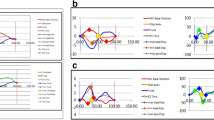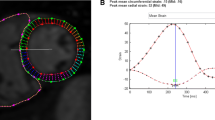Abstract
Background
The QRS-T angle has been associated with adverse cardiovascular events and sudden cardiac deaths. We determined frontal QRS-T angle in patients with complete transposition of the great arteries (TGA) after atrial switch operation and repaired tetralogy of Fallot (TOF) and explored its relationships with ventricular mechanics.
Methods
Thirty TGA patients aged 32.3 ± 4.4 years after atrial switch operation and 47 repaired TOF patients aged 28.7 ± 6.0 years were studied. The frontal planar QRS-T angle and QRS duration were measured from 12-lead electrocardiograms. Right (RV) and left ventricular (LV) strain parameters were determined using speckle tracking echocardiography.
Results
Compared with TOF patients, TGA patients after atrial switch operation had significantly greater frontal QRS-T angle (136.3° ± 43.5° vs 74.5° ± 59.6°, p < 0.001), greater prevalence of QRS-T angle ≥ 100° (83.3% vs 29.8%, p < 0.001), and showed progressive increase in QRS-T angle over a duration of 3.3 ± 1.0 years (p = 0.035). The QRS-T angle correlated positively with QRS duration in both the TGA (r = 0.61, p < 0.001) and TOF (r = 0.30, p < 0.043) groups. Among TGA patients, QRS-T angle was found to correlate negatively with systemic RV global longitudinal strain (r = − 0.49, p = 0.007), early diastolic strain rate (r = − 0.41, p = 0.026), and fractional area change (r = − 0.38, p = 0.045), but not subpulmonary LV strain indices. By contrast, among repaired TOF patients, there were no significant correlations between QRS-T angle and systemic and subpulmonary ventricular strain indices (all p > 0.05).
Conclusion
Increased frontal QRS-T angle is prevalent in TGA patients after atrial switch operation and is related to worse systemic RV mechanics.


Similar content being viewed by others
References
Rautaharju PM, Kooperberg C, Larson JC, LaCroix A (2006) Electrocardiographic predictors of incident congestive heart failure and all-cause mortality in postmenopausal women: the Women's Health Initiative. Circulation 113:481–489
Rautaharju PM, Kooperberg C, Larson JC, LaCroix A (2006) Electrocardiographic abnormalities that predict coronary heart disease events and mortality in postmenopausal women: the Women's Health Initiative. Circulation 113:473–480
Yamazaki T, Froelicher VF, Myers J, Chun S, Wang P (2005) Spatial QRS-T angle predicts cardiac death in a clinical population. Heart Rhythm 2:73–78
Kardys I, Kors JA, van der Meer IM, Hofman A, van der Kuip DA, Witteman JC (2003) Spatial QRS-T angle predicts cardiac death in a general population. Eur Heart J 24:1357–1364
Macfarlane PW (2012) The frontal plane QRS-T angle. Europace 14:773–775
Zhang ZM, Prineas RJ, Case D, Soliman EZ, Rautaharju PM, ARIC Research Group (2007) Comparison of the prognostic significance of the electrocardiographic QRS/T angles in predicting incident coronary heart disease and total mortality (from the atherosclerosis risk in communities study). Am J Cardiol 100:844–849
Gotsman I, Keren A, Hellman Y, Banker J, Lotan C, Zwas DR (2013) Usefulness of electrocardiographic frontal QRS-T angle to predict increased morbidity and mortality in patients with chronic heart failure. Am J Cardiol 111:1452–1459
Aro AL, Huikuri HV, Tikkanen JT, Junttila MJ, Rissanen HA, Reunanen A, Anttonen O (2012) QRS-T angle as a predictor of sudden cardiac death in a middle-aged general population. Europace 14:872–876
Selvaraj S, Ilkhanoff L, Burke MA, Freed BH, Lang RM, Martinez EE, Shah SJ (2014) Association of the frontal QRS-T angle with adverse cardiac remodeling, impaired left and right ventricular function, and worse outcomes in heart failure with preserved ejection fraction. J Am Soc Echocardiogr 27:74–82
Li YH, Ren XJ, Han ZH, Wang YL, Wang Y, Zhang JR, Chen F (2013) Value of the frontal planar QRS-T angle on cardiac dysfunction in patients with old myocardial infarction. Int J Clin Exp Med 6:688–692
Cuypers JA, Eindhoven JA, Slager MA, Opić P, Utens EM, Helbing WA, Witsenburg M, van den Bosch AE, Ouhlous M, van Domburg RT, Rizopoulos D, Meijboom FJ, Bogers AJ, Roos-Hesselink JW (2014) The natural and unnatural history of the Mustard procedure: long-term outcome up to 40 years. Eur Heart J 35:1666–1674
Turina MI, Siebenmann R, von Segesser L, Schönbeck M, Senning A (1989) Late functional deterioration after atrial correction for transposition of the great arteries. Circulation 80:I162–167
Frigiola A, Redington AN, Cullen S, Vogel M (2004) Pulmonary regurgitation is an important determinant of right ventricular contractile dysfunction in patients with surgically repaired tetralogy of Fallot. Circulation 110:153–157
Helbing WA, Niezen RA, Le Cessie S, van der Geest RJ, Ottenkamp J, de Roos A (1996) Right ventricular diastolic function in children with pulmonary regurgitation after repair of tetralogy of Fallot: volumetric evaluation by magnetic resonance velocity mapping. J Am Coll Cardiol 28:1827–1835
Chow PC, Liang XC, Cheung YF (2011) Diastolic ventricular interaction in patients after atrial switch for transposition of the great arteries: a speckle tracking echocardiographic study. Int J Cardiol 152:28–34
Cheung EW, Liang XC, Lam WW, Cheung YF (2009) Impact of right ventricular dilation on left ventricular myocardial deformation in patients after surgical repair of tetralogy of Fallot. Am J Cardiol 104:1264–1270
de Torbal A, Kors JA, van Herpen G, Meij S, Nelwan S, Simoons ML, Boersma E (2004) The electrical T-axis and the spatial QRS-T angle are independent predictors of long-term mortality in patients admitted with acute ischemic chest pain. Cardiology 101:199–207
Pavri BB, Hillis MB, Subacius H, Brumberg GE, Schaechter A, Levine JH, Kadish A, Defibrillators in Nonischemic Cardiomyopathy Treatment Evaluation (DEFINITE) Investigators (2008) Prognostic value and temporal behavior of the planar QRS-T angle in patients with nonischemic cardiomyopathy. Circulation 117:3181–3186
Biering-Sørensen T, Kabir M, Waks JW, Thomas J, Post WS, Soliman EZ, Buxton AE, Shah AM, Solomon SD, Tereshchenko LG (2018) Global ECG measures and cardiac structure and function: the ARIC study (atherosclerosis risk in communities). Circ Arrhythm Electrophysiol 11:e005961
Ladouceur M, Redheuil A, Soulat G, Delclaux C, Azizi M, Patel M, Chatellier G, Legendre A, Iserin L, Boudjemline Y, Bonnet D, Mousseaux E, STARS Investigators (2016) Longitudinal strain of systemic right ventricle correlates with exercise capacity in adult with transposition of the great arteries after atrial switch. Int J Cardiol 217:28–34
Sabate Rotes A, Bonnichsen CR, Reece CL, Connolly HM, Burkhart HM, Dearani JA, Eidem BW (2014) Long-term follow-up in repaired tetralogy of Fallot: can deformation imaging help identify optimal timing of pulmonary valve replacement? J Am Soc Echocardiogr 27:1305–1310
Diller GP, Radojevic J, Kempny A, Alonso-Gonzalez R, Emmanouil L, Orwat S, Swan L, Uebing A, Li W, Dimopoulos K, Gatzoulis MA, Baumgartner H (2012) Systemic right ventricular longitudinal strain is reduced in adults with transposition of the great arteries, relates to subpulmonary ventricular function, and predicts adverse clinical outcome. Am Heart J 163:859–866
Gatzoulis MA, Till JA, Somerville J, Redington AN (1995) Mechanoelectrical interaction in tetralogy of Fallot. QRS prolongation relates to right ventricular size and predicts malignant ventricular arrhythmias and sudden death. Circulation 92:231–237
Gokhale J, Husain N, Nicholson L, Texter KM, Zaidi AN, Cua CL (2013) QRS duration and mechanical dyssynchrony correlations with right ventricular function after Fontan procedure. J Am Soc Echocardiogr 2013:154–159
Murkofsky RL, Dangas G, Diamond JA, Mehta D, Schaffer A, Ambrose JA (1998) A prolonged QRS duration on surface electrocardiogram is a specific indicator of left ventricular dysfunction. J Am Coll Cardiol 32:476–482
Funding
None.
Author information
Authors and Affiliations
Contributions
L-YL designed the study, collected and interpreted the data and drafted the manuscript. EK-F So analyzed the imaging data and performed statistical analysis. Y-Fc and P-CC contributed to the conception of the study, data interpretation and final revision of the manuscript.
Corresponding author
Ethics declarations
Conflict of interest
The authors declare that they have no conflict of interest.
Additional information
Publisher's Note
Springer Nature remains neutral with regard to jurisdictional claims in published maps and institutional affiliations.
Rights and permissions
About this article
Cite this article
Lau, Ly., So, E.Kf., Chow, Pc. et al. Frontal QRS-T angle and ventricular mechanics in congenital heart disease. Heart Vessels 35, 1299–1306 (2020). https://doi.org/10.1007/s00380-020-01601-4
Received:
Accepted:
Published:
Issue Date:
DOI: https://doi.org/10.1007/s00380-020-01601-4




